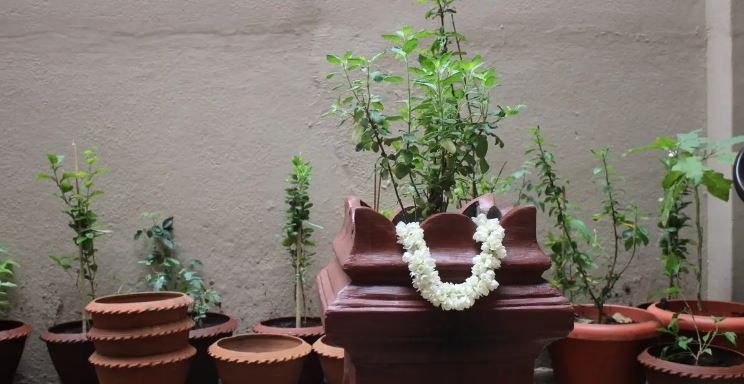
Due to its healing properties, tulsi is regarded as a sacred plant in India and is frequently found in Hindus’ homes. This plant, often known as basil, aids in the treatment of several seasonal illnesses like the common cold, the flu, and cough. A Tulsi plant promotes peace and harmony within the family, according to Vastu. So, where should your Tulsi plant be placed? Which Tulsi, according to Vastu, is best for a home? Follow this Vastu article to receive the greatest outcomes for your family and to spread the word about where to store the Tulsi plant according to Vastu in order to bring good fortune.
Where Should Tulsi Plants Be Placed at Home?

- Vastu Shastra provides specific instructions for you to follow if you want to build a simple Tulsi mandir design at home.
- Debris and waste should not be present near the Tulsi plant.
- Put an oil lamp next to the plant so people may see it.
- Vastu’s tulsi plant may be hydrated using a kalash. The Kalash should always be handled with two hands.
- Kumkum, Haldi, flowers, and incense should be offered to the god.
- While walking around the edge of the yoga mat, recite a shloka.
- You may also have a Tulsi chaura—a cement structure with four sides used to grow the revered Tulsi plant—in your house.
- Tulsi chaura can be constructed at the northeast corner of your balcony or outdoor space in accordance with Vastu Shastra.
- Another choice is the Vastu direction of the Tulsi plant, which points east.
- Wood or marble should be used to build the Tulsi mandir design construction.
- Verify that the area is neat and well-lit. You might light the plant with a ghee lamp.
Which Tulsi is Better – Rama and Shyama?

These two Tulsi plants can both be cultivated inside. Both the Rama and Shyama tulsi plants have long been recognised for their medicinal benefits. Holy Basil, also known as green Tulsi, is one of the most auspicious Tulsi plants accessible according to Vastu for Tulsi plant at home. In India, tulsi plants come in a variety of shapes and sizes.
The Tulsi with green leaves is referred to as “Shri-Tulsi,” also known as “lucky Tulsi,” “Rama-Tulsi,” or “bright Tulsi.” A plant known as Rama Tulsi (Ocimum Sanctum) is venerated in Hinduism for its healing properties and as a sacred sacrifice. Its tulsi leaves taste sweeter than those of other tulsi varieties.
It is referred known as “Shyama-Tulsi,” “dark Tulsi,” or “Krishna-Tulsi” if it has dark green or purple leaves and a purple stem. Because of its purple hue, which resembles Lord Krishna’s dark complexion, it is respected. Krishna Tulsi (Ocimum tenuiflorum), also known as Shyama Tulsi, is a Tulsi cultivar with unique medicinal characteristics that include healing respiratory issues, earaches, nasal lesions, and skin conditions. Indian kinds of tulsi include Vana Tulsi, also known as Wild Tulsi, and Kapoor Tulsi.
The Perfect Day to Plant and Pray: Unlocking the Mysteries of Tulsi Plant Worship

Hindu tradition accords the sacred Tulsi plant a special significance, and those who worship it are said to get blessings and wealth. But did you know that the Tulsi plant’s beneficial properties can be significantly influenced by the day it is planted and worshipped?
The greatest time to grow tulsi at home, according to Vaastu, is on a Wednesday or a Thursday during the Shukla Paksha (bright lunar phase). The Tulsi plant should be planted and worshipped during these days, according to tradition.
On the other hand, planting Tulsi on a Saturday is frowned upon. This is due to the fact that Saturday is linked to the planet Saturn, and it is said that planting Tulsi on this day can result in negative energy and difficulties.
One can worship the Tulsi plant at home by giving it daily offerings of water, milk, and honey. The mantra is recited—
Saying “Om Namo Bhagavate Vasudevaya”
while it’s also thought that watering the plant will increase its beneficial effects.
Vastu Directions For Tulsi Plant Placement

- According to Vastu, the Tulsi plant should be facing in the direction that benefits the home’s residents.
- The first Vastu rule for growing tulsi at home is having a favourable site. Tulsi plants should be grown in the north and northeastern directions of the home, according to vaastu principles. Positive energy is generated throughout the house as the water flows, dispersing any bad energy that may be present.
- Maintain the health of the tulsi plant: While kept inside, tulsi is a well-known herb that requires attention and shouldn’t be allowed to dry out or become damaged.
- The Tulsi plant, which has the power to drive out all disease and negative energy, can bring good energy and mental tranquilly into your home.
- This plant shouldn’t be kept in a difficult-to-maintain location. In Vastu, the southeast is referred to as the “direction of fire.” As a result, Tulsi cannot grow well here.
- Tulsi should never be planted in the ground for the greatest results; keep it in a planter at all times.
- It is a Hindu plant that wedded Hindu devotees in private homes in order to guarantee a happy and successful union. As per Vastu Shastra, tulsi is a lucky herb.
- Tulsi plants need to be kept in pristine conditions without being covered, and filthy objects like brooms and mop heads shouldn’t be left close by.
- The best number of Tulsi plants to be planted at a specific place is advised to be odd numbers, such as one, three, five, or more.
- It can be used to speed up recovery: Vastu principles suggest that growing Tulsi plants can help prevent disease and strife.
- A Tulsi plant should ideally be put where it will receive enough sunlight and other natural elements to grow and live a long period. The area needs to be well-lit.
To read more such news, download Bharat Express news apps


















